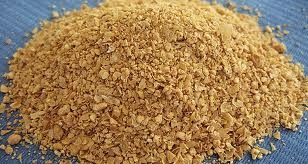Soya Bean Meal Under The Spotlight
10 June 2019As was mentioned in last month’s Straights Update in Milk Manager News, the demand for soya has significantly decreased due to the outbreak of swine flu in China, coupled with the potential US and Chinese trade deal still in negotiation. This has resulted in a decrease globally of soya price. However disastrous planting conditions in the US could have caused the sudden rise we have seen in the last week (Frontier 06/06/19).
The Value of Soya
Soya Bean Meal is well known as a highly valuable protein source because of its high protein content and amino acid composition. Soya is also attractive due to its higher level of DUP (digestible undegradable protein) compared to other protein sources. This means some of the soya is able to “bypass” the rumen (where it would be broken down and utilised by rumen bugs), and enter the large intestine where digested nutrients are available straight to the cow. DUP is an essential component of dairy cow diets, as due to their production, the demand from protein cannot be met fully by protein from rumen microbes. The higher the yield, the increased requirement for DUP.
In the UK there are two types of soya that we commonly feed to livestock; Hipro and IMSA. These products contain either 48% or 44% crude protein on an as-fed basis (54.5% and 50% on a dry matter basis, respectively). The 48% meal (Hipro) contains about 8% neutral detergent fibre (NDF) and is dehulled, whereas the 44% meal (IMSA) is adjusted to 14% NDF by blending it with toasted ground soybean hulls. Approximate delivered price of these straights as of 6th June was £298/t for IMSA and £320/t for Hipro.
Protected Protein Sources
There are some specially treated soya products on the market which increases the DUP value of soya by around double. The process under which they are created ensures that the protein becomes highly rumen undegradable but retains the high intestinal digestibility similar to untreated soya. This has a valuable place in UK diets where the main component of dairy cow diets (grass/grass silage) has a high percentage of effective rumen degradable protein (ERDP) and untreated soya, although has a comparatively high level of DUP, is still mostly used within the rumen.
An alternative protein to soya which is grown in the UK is rapeseed meal. Many studies indicate that the specially treated or “protected” rapeseed meal performs just as well as soya in dairy cow diets, although more is required to achieve the same protein content. It was also found that cows fed protected rapeseed meal had lower urea content in milk, indicating a better utilisation of nitrogen compared to soya.
Comparative Feed Value
Cash flow is always going to be one of the main concerns for a farming business, so it is no surprise that most farmers when looking to buy in feed are concerned about cost/tonne. However, it will be more efficient and easier on the bank balance in the long run to look at comparative feed value.
The below table demonstrates at what price feeds are “good value” to buy, based on their energy and crude protein content (note this does not take into account DUP or ERDP). The value indicates at what price a feed is a worthwhile purchase based on wheat being priced at X and soya being priced at Y. Anything above the value below is considered not favourable e.g. if wheat is £170/t and Soya is £335 you may want to think twice about buying rapeseed meal that is more than £258/t.
| Feed | £/t | ||||||||
|---|---|---|---|---|---|---|---|---|---|
| Wheat | 150 | 170 | 190 | ||||||
| Hipro Soya (48%) | 305 | 335 | 365 | 305 | 335 | 365 | 305 | 335 | 365 |
| Rape Seed Meal | 234 | 254 | 274 | 238 | 258 | 278 | 241 | 262 | 282 |
| Maize Distillers | 223 | 237 | 251 | 235 | 248 | 262 | 246 | 260 | 273 |
| Wheat Distillers | 234 | 251 | 268 | 242 | 259 | 276 | 250 | 267 | 284 |
| Barley | 145 | 145 | 145 | 165 | 164 | 164 | 184 | 184 | 184 |
| Maize | 144 | 143 | 141 | 166 | 164 | 162 | 187 | 185 | 184 |
| Oats | 130 | 130 | 129 | 148 | 148 | 147 | 166 | 166 | 165 |
| Beans | 211 | 223 | 236 | 221 | 234 | 247 | 232 | 245 | 258 |
| Peas | 201 | 211 | 222 | 214 | 224 | 235 | 227 | 237 | 247 |
| Biscuit Meal | 168 | 168 | 167 | 192 | 191 | 191 | 215 | 214 | 214 |
| Sugar Beet | 138 | 137 | 136 | 158 | 157 | 156 | 178 | 177 | 175 |
Maimie Sloane, maimie.sloane@sac.co.uk
Sign up to the FAS newsletter
Receive updates on news, events and publications from Scotland’s Farm Advisory Service

